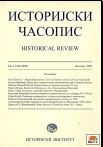Вршац у средњем веку II део: од почетка 15. до средине 16. столећа
Vršac in the Middle Ages Part II: from the Begining of the 15th to the Middle of the 16th Century
Author(s): Aleksandar KrstićSubject(s): History
Published by: Istorijski institut, Beograd
Keywords: Vršac; Ér(d)somlyó; Banat; the Midlle Ages; Hungary; Serbia; Đurađ Branković; János Hunyadi; Peter Dóci; castle.
Summary/Abstract: The castle of Ér(d)somlyó (Vršac) has gained on importance from the end of the 14th century, when started first Ottoman raids in the Danubian basin area. Hungarian king Sigismund (1387-1437) had donated Érsomlyó with his estate to Serbian despot before 1431, but king Wladislas I (1440-1444) temporary deprived despot Đurađ Branković (1427-1456) of Vršac in 1440. Despot Đurađ mortgaged Érsomlyó and some other estates in Hungary to János Hunyadi in 1444, as compensation for military help in the so–called „long campaign“ against the Ottomans (1443-1444). During the next decade, Vršac was an object of dispute between the Serbian ruler and János Hunyadi, changing its owner for several times. After the Ottoman occupation of Serbia in 1459, the Branković family lost all its estates in Hungary. Vršac became the property of king’s uncle Michael Szilágyi, who was executed in Constantinople in 1461. King Matthias Corvinus (1458-1490) donated Érsomlyó to Peter Dóci, the count of Temes, in 1472, and at the beginning of the 16th century the castle was again a part of the royal domain. The second half of the 15th and the first half of the 16th century was a period of intensive Serbian migrations in Banat and other parts of southern Hungary. By the end of that period, Serbs constituted the majority of the population in southern Banat. Nevertheless, there is a very limited amount of information оn the urban and economic development and population of the Érsomlyó settlement, lying underneath the identically named fortification. The settlement was mentioned as a market place in 1330, and a status of town had gained at the end of the 14th or at the begining of the 15th century (it was mentioned as civitas in 1416). The archaeological findings from the castle on the hill Vršački breg suggest a certain level of trade and craftsman activity. The Ottomans captured Vršac in 1552.
Journal: Историјски часопис
- Issue Year: 2011
- Issue No: 60
- Page Range: 193-212
- Page Count: 20
- Language: Serbian

